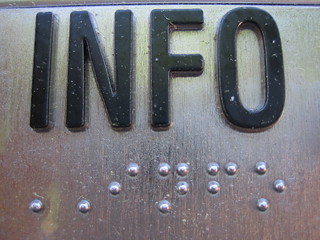Howdy, Hello, and Ahoy-hoy!
My name is Jerry Mah and ETEC 540 will be my seventh course in my journey through MET. I am also taking ETEC 531 (Cultural and New Media Studies) this term. I currently reside in Calgary, AB. These two courses will tie nicely with my work in a recent course (ETEC 532: Technology in the Arts and Humanities).
INFO (c) bobafred, CC BY-NC-ND 2.0
For the purposes of this introduction, I found this picture to be perfect for conveying my desire to make knowledge more accessible. The abbreviation of information, coupled with Braille characters provided an interesting visual combination. In my eyes, it provides a different dimension of accessibility – one which the majority of us do not typically consider for accessing text. Further to this, how are we as educators making knowledge accessible, even if one can “visualize” it? One of our primary communication mediums is through print – text. It is my hope that this class will bring new layers to my understanding in the areas of writing, reading, and technology.
My current work involves supporting schools with a number of initiatives. In the past, I have taught a wide variety of core classes, along with complementary classes in: film studies, building construction, industrial technologies, and robotics at the middle/junior school level.
Thanks for reading my introduction. I look forward to learning with you all,
-Jerry



Hi Jerry,
I wonder what Ong would have to say about the impact of braille. That would be a good topic to research. You’re right because we don’t usually think of texture being used for reading. It’s thought-provoking.
I imagine it would have many of the same effects as print because of braille’s permanence; however, the fact that it takes longer to read and takes up more space on a page causes books written in braille to be truncated. If we were to communicate widely with braille, I bet concision would be even more important than it is now. I also bet that our vocabulary would prefer shorter words.
Thanks,
Chris